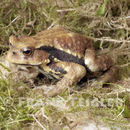Description
(
englanti
)
tarjonnut AmphibiaWeb articles
Bufo japonicus has a robust body and a triangular head with a pointed snout and short and thick limbs. Body color varies from dark green, yellow-brown to dark-brown depending on locality. Numerous round tubercles can be seen on the limbs, back, and lateral side of the trunk. Warts and parotoid glands above the tympanum secrete venom when attacked by a predator. In the breeding season, males and females have smoother skin, and the male's body color tends to become more yellowish. The snout-vent length ranges from 43-162 mm for B.j.formosus and 80-176 mm for B.j.japonicus. Females' body length is usually larger than males. Bufo japonicus living in warmer regions, on average, have greater snout-vent length. The tympanum is elliptical, and the eye-tympanum distance is about equal length to the long axis of tympanum. The fore-limb, with four fingers, is about half the length of the hind-limb; the third finger is the longest and the second is shortest. Hind-limb is nearly twice as long as the body; the fourth toe longest and the first toe shortest of all five toes. Webbing is poorly developed with deep incisions.
- Hirai, T., and Matui, M. (2002). ''Feeding ecology of Bufo japonicus formosus from the montane region of Kyoto, Japan.'' Journal of Herpetology, 36(4), 719-723.
- Ishii, S., Kaji, S., and Nakazawa, H. (2000). ''Oscillatory electric potential on the olfactory epithelium observed during the breeding migration period in the Japanese toad, Bufo japonicus.'' Zoological Science, 17(3), 293-300.
- Ishii, S., Kubokawa, K., Kikuchi, M., and Nishio, H. (1995). ''Orientation of the toad, Bufo japonicus, toward the breeding pond.'' Zoological Science, 12(4), 475-84.
- Maeda, N. and Matsui, M. (1990). Frogs and Toads of Japan, 2nd edition. Bun-Ichi Sogo Shuppan Co., Ltd., Tokyo, Japan.
- Okada, Y. (1966). Fauna Japonica Anura. Tokyo Electrical Engineering College Press, Tokyo.
Distribution and Habitat
(
englanti
)
tarjonnut AmphibiaWeb articles
Bufo japonicus is widely distributed in Japan. The habitat ranges from sea level to high mountain regions. Bufo japonicus japonicus (Hihon-hikigaeru) is found in western Japan; Kyusyu, Shikoku, middle and south part of Honshu. Bufo japonicus formosus (Azuma-Hikigaeru) distributes in Eastern part of Japan, from southern Hokkaido and north eastern part of Honsyu. B.i.japonicus has smaller tympanums than B.j.formosus, otherwise they are morphologically very similar. However, protein composition analysis reveals genetic differentiation between B.j.formosus and B.j.japonicus.
Life History, Abundance, Activity, and Special Behaviors
(
englanti
)
tarjonnut AmphibiaWeb articles
This species spends most of its adult life on ground, and migrate to water only for breeding. Breeding occurs between February and March in lowland areas when the temperature raises above 6 to 7 degrees. Breeding at one site last up to one week. Bufo japonicus are thought to track the route to a breeding site using olfactory cues while mating behaviors are triggered by visual cues(Ishii 1995; Ishii 2000). The breeding takes place in ponds, swamps, and puddles. Males usually outnumber females at the breeding site, often three to ten males for one female. Scrumble competitions between many males are observed during the breeding season. Long, string-like egg masses containing 1,500-14,000 eggs are laid on the bottoms of shallow water bodies, entangled among aquatic plats. Larvae have a completlely dark body and reach 30-40mm upon maturation. Metamorphosis occurs in June. Sexual maturity takes about a year for males and two years for females. Bufo japonicus feeds on a wide variety of arthropods and earthworms. According to Hirai's study (2000), diets of Bufo japonicus include ants, carotid and harpalid beetles, which are avoided by other predators because of the unpalatable chemical contents ( formic acid and quinones, respectively.) Hirai (2000) suggests that the wide variety of diet may reduced food-related competition with other species and contributed to the wide distribution of Bufo japonicus in Japan. Bufo japonicus buries itself under soils to hibernate when the temperature falls below 6 degrees.
Life History, Abundance, Activity, and Special Behaviors
(
englanti
)
tarjonnut AmphibiaWeb articles
Decrease of rice drainage of rice paddies during the winter time in recent years decreased the availablity of breeding sites for Bufo japonicus in early spring. Rapid population declines have been observed in western Japan.
Relation to Humans
(
englanti
)
tarjonnut AmphibiaWeb articles
In traditional Japanese medicine, the vemon from the parotoid glands of Bufo japonicus was processed and used to apply topically on cuts and burns.

